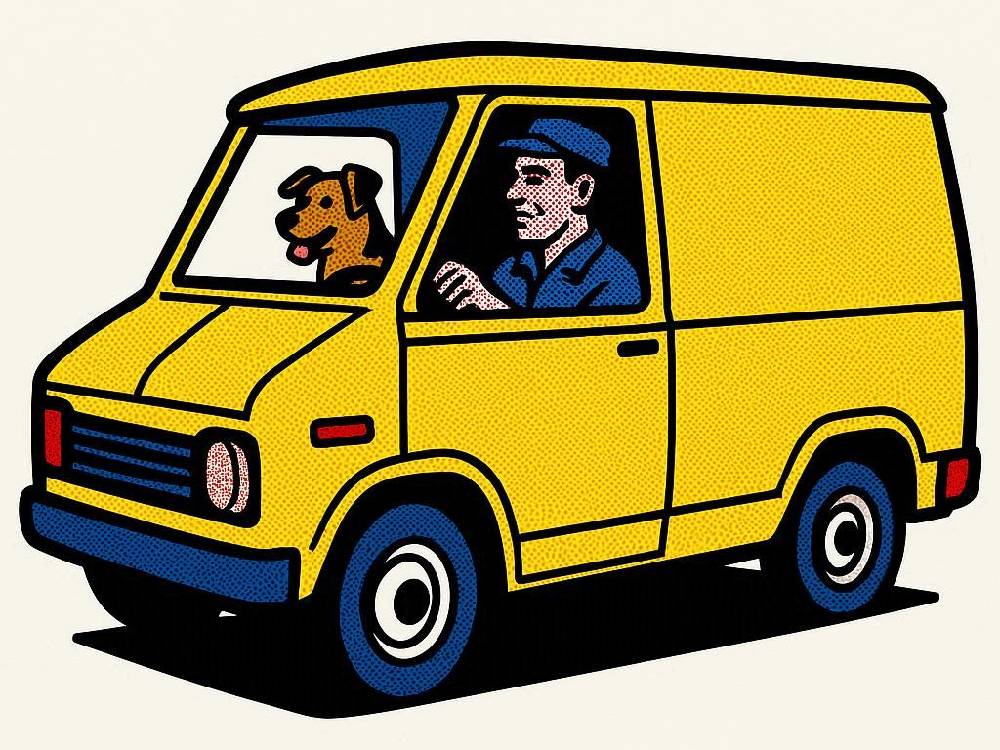Introduction
Van insurance…
Ever wondered if you can take your furry mate to work in your trusty Transit?
You’re not alone.
Across the UK, tradespeople, couriers, and van owners are loading up their tools — and their dogs — before hitting the road.
But here’s the catch:
Taking your dog to work could affect your van insurance more than you think.
Let’s break it down.
Why Taking Your Dog To Work Isn’t As Simple As It Sounds
You love your dog.
They’re part of the family — loyal, calm, and great company on long drives.
But while bringing them to work might sound harmless, insurers see things differently.
Here’s why:
Insurers assess risk.
And dogs, especially when unrestrained, can be a liability.
They might distract you, damage upholstery, or cause injury in an accident.
So, if your insurer wasn’t told about your canine passenger, your policy might not cover it.
For instance, if your dog jumps forward and causes a crash, your insurer could reject your claim.
That’s where clarity becomes crucial.
Learn how your van is officially classified here — Are you driving a car or a van? Check your insurance policy.
Because if your van is misclassified, it might void your cover completely.
What UK Law Says About Dogs In Vans
Let’s get one thing straight.
The UK law doesn’t ban dogs from vans.
But it does require that animals are “suitably restrained” so they can’t distract the driver or injure passengers.
This rule falls under Rule 57 of the Highway Code.
It’s not optional — it’s mandatory for safety.
A seat belt harness, crate, or dog guard should always be used.
If your dog causes an accident, you could be fined up to £5,000 and face points on your licence.
Worse still, your Van Insurance could be invalidated.
It’s not just about being a responsible pet owner — it’s about staying protected.
Curious how compliance connects to insurance?
Find out more in Why proper vehicle compliance is crucial for road safety.
How Dogs In Vans Can Affect Your Van Insurance Policy
Now, here’s where things get serious.
Bringing your dog to work can change the entire risk profile of your policy.
Some insurers might see your pet as a passenger.
Others might treat them as cargo.
And that distinction matters.
You might need an add-on or special pet coverage.
It’s worth calling your insurer before you travel — don’t wait until after something happens.
Dogs also increase the likelihood of accidental damage claims.
For example, muddy paws on electronics, chewed seatbelts, or scratches on upholstery can all fall outside standard cover.
That’s where specialist insurers come in.
They understand that pets are part of the job for many tradespeople.
Van Insurance: Business Use vs. Personal Use — Does It Matter?
Absolutely.
If your van is insured for business use, your policy already assumes a higher level of risk.
But here’s the twist — if you regularly take your dog to work, that can affect your policy type.
Why?
Because “carriage of goods” doesn’t automatically include “carriage of pets.”
Even something as simple as having your dog onboard during business hours can alter how your van’s use is categorised.
Some insurers might treat it as mixed use, especially if you’re visiting clients or sites.
This could mean higher premiums — or worse, non-coverage if you haven’t disclosed it.
Want to know if business cover could work out cheaper overall?
Here’s the answer: Is business van insurance cheaper?
It’s one of those small details that can make or break your next renewal quote.
Common Mistakes Drivers Make With Pets And Van Insurance
Let’s be honest — most drivers assume their dog’s covered automatically.
But that’s a costly mistake.
Many policies exclude damage or distraction caused by animals.
And if your dog breaks a window trying to chase a squirrel?
You’ll likely be paying for that repair yourself.
The same goes for accidents.
If your insurer finds the dog was a contributing factor, your claim might be refused.
That’s why it pays to drive smarter.
Modern telematics devices can help prove that your driving was steady and controlled — even with a pet onboard.
They can even lower your premiums.
Check out How telematics devices can save you money on van insurance.
Because when it comes to Cheap Van Insurance, data is your best friend.
How To Stay Insured When Bringing Your Dog To Work
So, what’s the smart move if your dog’s part of your workday?
Simple — plan ahead.
Because the last thing you want is to find out you’re uninsured after something goes wrong.
To begin with, always review your current Van Insurance policy.
If you spot vague wording around “passengers” or “cargo,” it’s time to clarify things.
That’s because dogs don’t automatically fit into either category.
As a result, insurers can interpret your cover differently.
Therefore, it’s crucial to be specific.
Even something as simple as using a crate can reduce perceived risk.
Moreover, you can apply other strategies to lower costs.
Take a look at 10 simple hacks to instantly lower your van insurance and save big.
Why It Pays To Be Honest With Your Insurer
Let’s talk about transparency — because it’s everything.
Many van drivers assume small details, like a dog in the back, won’t matter.
However, insurers see things differently.
Since your policy depends on accurate information, even a minor omission can void it.
In short, honesty protects your wallet.
If an accident happens and you’ve failed to disclose that your dog travels with you, your claim could be rejected.
Worse still, you might face policy cancellation or premium penalties in future renewals.
Consequently, being upfront not only saves you from trouble but may even unlock better rates.
Furthermore, some insurers reward proactive customers with loyalty bonuses or reduced excesses.
For instance, one unfortunate driver learned this lesson after a lapse in cover —
How a simple van insurance lapse led to court — learn why.
Ultimately, honesty isn’t just the best policy — it’s the cheapest policy.
Conclusion
So, can you take your dog to work in your Transit van?
Absolutely — but only if you follow the rules.
First, ensure your Van Insurance policy allows for animal passengers.
Then, restrain your dog safely according to the Highway Code.
After that, keep your insurer informed about your setup.
Because when it comes to protecting your furry co-worker, assumptions don’t count — only declarations do.
In addition, remember that transparency saves time, money, and stress later on.
That’s why reviewing your policy regularly is vital.
By staying proactive, you’ll not only protect your dog but also unlock access to the Cheapest Van Insurance UK deals available.
Want to dig deeper?
Here are some related reads that expand on this topic:





